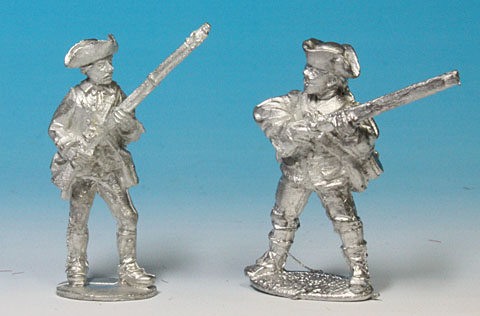Fife Drum Minis Forum
JANUARY 30, 2019: New Fife & Drum Miniatures AWI Highlanders greens are on their way to Griffin Moulds for casting. Below are pictures of the (1) Highlanders skirmishing, (2) infantry command figures, (3) center company soldiers, and (4) mounted Highlander officer.
At the beginning of the war, each infantry company was entitled to 2 'field musicians', one of which was a drummer and one of which was a fifer. A cavalry troop was entitled to two buglers.
The regiment (10 companies) was also authorized to have a principal fifer and a principal drummer assigned to the regimental staff, to be in charge of all field musicians. These authorized allotments never changed, although many regiments would,as the war progressed, have fewer than the authorized number of field musicians.At the beginning of the war, each regiment (north and south) was theoretically authorized to also have a marching band. Many or most did not have a band. Where a band existed, it would typically have anywhere from 8 to 16 bandsman, most of whom played brass instruments.

The band would have its own drummer or two, including potentially a bass drummer, plus would have a band leader. The band was a completely separate musical organization from the fife & drum corps.In 1862, the Union forces abolished regimental bands as an economy measure (the regimental fife & drum corps was maintained). In place of a regimental band, each brigade (of 5-6 regiments, typically) would have one band, that was authorized 24 bandsmen plus one band leader. Not all brigades had bands, and some regiments (those with particularly good bands?) ignored or evaded the mandate to abolish regimental bands.For the Confederates, a modest percentage of regiments had small regimental bands through the end of the war.The function of the band and the fife & drum corps were different: the band played morale-building popular music, and served as stretcher bearers during battle. The fife & drum corps was a musical public address system, announcing orders to the troops by a series of calls (assembly, mess call, sick call, guard mount etc.). War Department General Order No. 48, issued 31 July 1861, entitled two 'field' musicians per company (bugler or fife and drummer), and a separate band of 16-24 musicians.
At the end of 1861, owing to attrition, regimental bands were largely disbanded in the Union armies, but provision was made for a 16-piece brass band at the brigade level. Some regimental bands remained intact, but served their entire brigade. Something similar occurred in the Confederate armies as the war progressed.
On 11 September 1863, during Gen. Lee's review of his Army of Northern Virginia, 17 bands participated.Music took other forms as well. As of 1862, Hampton's Battery F (Pennsylvania) had a string band. A handful of 'drum corps' existed in both armies, like the famous Mozart Drum Corps of the 40th New York.Band drums included the bass drum and kettle drum. The snare (or tenor) drum typically served as the 'field' drum.Here are some references to the bass drum that I have found:- (Compiled Service Records, H.
Bell, 18th Georgia, 26 April 1864) Requisition for one bass drum and one kettle drum, the musicians being entirely out of anything of the kind.- (Voices from Company D, 5th Alabama) As of 24 May 1863, now have a good band, fife, two kettle and one bass drum.- (History of the 88th Pennsylvania Volunteers in the War for the Union, 1861-1865, by John T. Vautier) In 1861, band leader E. Ermentrout brought from Reading an excellent band of 20 pieces, including a bass drum.- (The Story of Our Regiment, A History of the 148th Pennsylvania) The field music or drum corps of the regiment was originally composed of the regulation two musicians per company, a fifer and a tenor (snare) drummer, plus one (big) bass drum (Billy Ishler, Company G), and one Chief Musician or Drum Major (R. Beaver ordered a complete equipment of fifes and drums, which were manufactured in Baltimore.- (Music on the March, Frank Rauscher, 114th Pennsylvania) 30 June 1863, the band. Was in a demoralized condition; both heads of the bass drum were broken, the snare drum was ruptured, and other instruments were out of order.- (History of the Fortieth (Mozart) Regiment, New York Volunteers, by Floyd) As of late 1861, the Mozart Drum Corps in camp consisted of 20 snare drummers, half a dozen fifers and a bass drummer.
Fife & Drum Hessian Musketeers. Click picture to enlarge the view.New Warmgamer Discussion ForumI have decided to take a hand at trying out a discussion forum for primarily Fife & Drum/Minden Miniatures as well as topics related to the Seven Years War, French & Indian War, War of the Austrian Succession and the American Revolutionary War (or AWI, if you will).A forum is only as good as its members and their level of contribution to discussions or the creation of topics, so we shall see how this goes.
Fife Drum Minis Forum Reviews
Hopefully the forum will have some legs and get up and running very quickly.I will start populating the forum with some topics and threads for discussion. Please click on the link above, pay the forum a visit, and feel free to start your own threads or contribute to existing ones.I look forward to seeing many of my regular blog visitors in the Fife & Drum Minis forum.